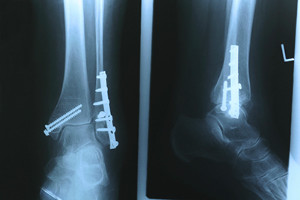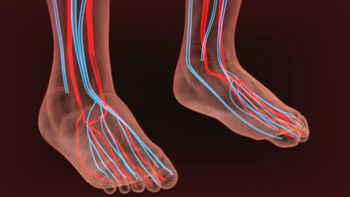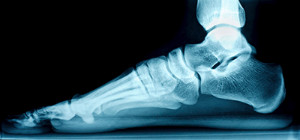Items filtered by date: July 2020
Reasons to Visit a Podiatrist
 Podiatrists can assess the foot’s health and provide a variety of treatment options for foot-related issues. One of the keys to proper foot health is making sure to visit a podiatrist early and take preventative steps. If you are feeling pain in your feet or ankles, the pain may be caused by a broken or fractured bone, a sprain, or tendonitis. Patients with diabetes should have yearly foot examinations since they may not be able to feel certain foot conditions due to reduced blood flow. Patients suffering from heel pain should also visit a podiatrist in case they have a heel spur or plantar fasciitis. Podiatrists are also able to treat corns, calluses, and bunions. All of these conditions can be painful to deal with on a daily basis. If you are experiencing any problems with your feet or ankles, please be sure to consult with a podiatrist for proper treatment options.
Podiatrists can assess the foot’s health and provide a variety of treatment options for foot-related issues. One of the keys to proper foot health is making sure to visit a podiatrist early and take preventative steps. If you are feeling pain in your feet or ankles, the pain may be caused by a broken or fractured bone, a sprain, or tendonitis. Patients with diabetes should have yearly foot examinations since they may not be able to feel certain foot conditions due to reduced blood flow. Patients suffering from heel pain should also visit a podiatrist in case they have a heel spur or plantar fasciitis. Podiatrists are also able to treat corns, calluses, and bunions. All of these conditions can be painful to deal with on a daily basis. If you are experiencing any problems with your feet or ankles, please be sure to consult with a podiatrist for proper treatment options.
If you are experiencing pain in the feet or ankles, don’t join the stubborn majority refusing treatment. Feel free to contact Dr. Steven Sheridan from Ankle & Foot Specialty Clinics. Our doctor can provide the care you need to keep you pain-free and on your feet.
What Is a Podiatrist?
Someone would seek the care of a podiatrist if they have suffered a foot injury or have common foot ailments such as heal spurs, bunions, arch problems, deformities, ingrown toenails, corns, foot and ankle problems, etc.
Podiatric Treatment
A podiatrist will treat the problematic areas of the feet, ankle or lower leg by prescribing the following:
- Physical therapy
- Drugs
- Orthotic inserts or soles
- Surgery on lower extremity fractures
A common podiatric procedure a podiatrist will use is a scanner or force plate which will allow the podiatrist to know the designs of orthotics. Patients are then told to follow a series of tasks to complete the treatment. The computer will scan the foot a see which areas show weight distribution and pressure points. The podiatrist will read the analysis and then determine which treatment plans are available.
If you have any questions please feel free to contact our office located in Sandusky, MI . We offer the newest diagnostic and treatment technologies for all your foot and ankle needs.
Lowering Your Risk of Peripheral Artery Disease
Peripheral Artery Disease (PAD) is a circulatory issue in which plaque builds up along the walls of your blood vessels, causing them to narrow and reducing blood flow to your limbs. This typically results in leg pain, numbness, or weakness. PAD has become increasingly common, afflicting over 200 million adults worldwide. Left undiagnosed and untreated, PAD can progress to critical limb ischemia, a severe restriction of blood flow to the affected limb, which is associated with a high risk of amputation. Fortunately, there are steps that you can take to lower your risk of developing PAD and its complications, including eating a balanced diet, exercising regularly, maintaining a healthy weight, and getting regular check ups by your doctor. If you are experiencing pain or numbness in your legs or feet, please visit a podiatrist who can perform diagnostic testing for PAD and provide treatment options.
Peripheral artery disease can pose a serious risk to your health. It can increase the risk of stroke and heart attack. If you have symptoms of peripheral artery disease, consult with Dr. Steven Sheridan from Ankle & Foot Specialty Clinics. Our doctor will assess your condition and provide you with quality foot and ankle treatment.
Peripheral artery disease (PAD) is when arteries are constricted due to plaque (fatty deposits) build-up. This results in less blood flow to the legs and other extremities. The main cause of PAD is atherosclerosis, in which plaque builds up in the arteries.
Symptoms
Symptoms of PAD include:
- Claudication (leg pain from walking)
- Numbness in legs
- Decrease in growth of leg hair and toenails
- Paleness of the skin
- Erectile dysfunction
- Sores and wounds on legs and feet that won’t heal
- Coldness in one leg
It is important to note that a majority of individuals never show any symptoms of PAD.
Diagnosis
While PAD occurs in the legs and arteries, Podiatrists can diagnose PAD. Podiatrists utilize a test called an ankle-brachial index (ABI). An ABI test compares blood pressure in your arm to you ankle to see if any abnormality occurs. Ultrasound and imaging devices may also be used.
Treatment
Fortunately, lifestyle changes such as maintaining a healthy diet, exercising, managing cholesterol and blood sugar levels, and quitting smoking, can all treat PAD. Medications that prevent clots from occurring can be prescribed. Finally, in some cases, surgery may be recommended.
If you have any questions, please feel free to contact our office located in Sandusky, MI . We offer the newest diagnostic and treatment technologies for all your foot care needs.
What Can Cause a Stress Fracture?
 A stress fracture is a common sports injury, often brought upon by overuse and repetitive activities. Stress fractures can occur when small cracks form in the bone. Quite often athletes may develop a stress fracture due to errors in their training technique. For example, it can be very damaging to suddenly increase the intensity of a work-out regime or to increase the amount of walking one does. Increasing the difficulty of training over the course of a few months can be much safer as opposed to a few weeks. Other factors such as improper equipment can also lead to the development of a stress fracture. Worn-out footwear, or shoes that are too stiff can also be damaging to how one performs their training. For further information on how to prevent getting a stress fracture, please consult with a podiatrist.
A stress fracture is a common sports injury, often brought upon by overuse and repetitive activities. Stress fractures can occur when small cracks form in the bone. Quite often athletes may develop a stress fracture due to errors in their training technique. For example, it can be very damaging to suddenly increase the intensity of a work-out regime or to increase the amount of walking one does. Increasing the difficulty of training over the course of a few months can be much safer as opposed to a few weeks. Other factors such as improper equipment can also lead to the development of a stress fracture. Worn-out footwear, or shoes that are too stiff can also be damaging to how one performs their training. For further information on how to prevent getting a stress fracture, please consult with a podiatrist.
Activities where too much pressure is put on the feet can cause stress fractures. To learn more, contact Dr. Steven Sheridan from Ankle & Foot Specialty Clinics. Our doctor can provide the care you need to keep your pain free and on your feet.
Dealing with Stress Fractures of the Foot and Ankle
Stress fractures occur in the foot and ankle when muscles in these areas weaken from too much or too little use. The feet and ankles then lose support when walking or running from the impact of the ground. Since there is no protection, the bones receive the full impact of each step. Stress on the feet can cause cracks to form in the bones, thus creating stress fractures.
What Are Stress Fractures?
Stress fractures occur frequently in individuals whose daily activities cause great impact on the feet and ankles. Stress factors are most common among:
- Runners
- People affected with Osteoporosis
- Tennis or basketball players
- Gymnasts
- High impact workouts
Symptoms
Pain from the fractures occur in the area of the fractures and can be constant or intermittent. It will often cause sharp or dull pain with swelling and tenderness. Engaging in any kind of activity which involves high impact will aggravate pain.
If you have any questions please feel free to contact our office located in Sandusky, MI . We offer the newest diagnostic and treatment technologies for all your foot and ankle needs.
Arthritis Can Cause Pain in the Feet and Ankles
What Are the Different Types of Flat Feet?
Flat feet is a condition known for causing fallen arches, meaning the feet lay completely flat on the floor. There are two different kinds of flat feet one may experience, rigid and flexible. A flexible flat foot has an arch when resting, however, when standing or walking, the arch then disappears. This type of flat foot is often common among pediatric aged patients. A rigid flat foot develops during adulthood due to the weakening of the tibialis posterior muscle tendon. This type of flat foot may worsen over time and can cause pain and swelling in the feet, particularly the inside arch of the foot and ankle. Rigid flat foot may eventually lead to arthritis as well. For a proper diagnosis and recommended treatment plan, it’s suggested that you consult with a podiatrist.
Flatfoot is a condition many people suffer from. If you have flat feet, contact Dr. Steven Sheridan from Ankle & Foot Specialty Clinics. Our doctor will treat your foot and ankle needs.
What Are Flat Feet?
Flatfoot is a condition in which the arch of the foot is depressed and the sole of the foot is almost completely in contact with the ground. About 20-30% of the population generally has flat feet because their arches never formed during growth.
Conditions & Problems:
Having flat feet makes it difficult to run or walk because of the stress placed on the ankles.
Alignment – The general alignment of your legs can be disrupted, because the ankles move inward which can cause major discomfort.
Knees – If you have complications with your knees, flat feet can be a contributor to arthritis in that area.
Symptoms
- Pain around the heel or arch area
- Trouble standing on the tip toe
- Swelling around the inside of the ankle
- Flat look to one or both feet
- Having your shoes feel uneven when worn
Treatment
If you are experiencing pain and stress on the foot you may weaken the posterior tibial tendon, which runs around the inside of the ankle.
If you have any questions please feel free to contact our office located in Sandusky, MI . We offer the newest diagnostic and treatment technologies for all your foot and ankle needs.



